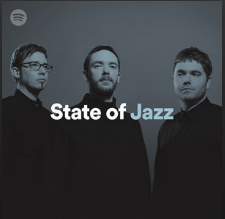Why Spotify is the best, and the worst.
Spotify raises some serious issues for artists and independent labels these days. Jim Tuerk, who works with us here at Greenleaf Music, has done a lot of thinking (and a lot of listening) around Spotify and other music services. He wrote some of his thoughts down recently and I believe Greenleaf followers will find them interesting and thought-provoking. Enjoy. —Dave Douglas
I’ve been streaming music on Spotify like it’s going out of style these past few months. The free version was just alright, but as with many in the digital music generation, I hate ads. And as you might guess, I have a pretty expansive iTunes library, so it wasn’t a priority to get in deeper with a paid account——paid accounts remove ads and allow you streaming capabilities on your phone. When I did take the plunge into the paid application, it was mostly so I could stay current with new releases in the indie rock world——something I doze off on sometimes only to be met with, “You haven’t heard _____?!” from one of my friends. And I have to say I am pretty hooked now.
 A friend of mine recently equated Spotify to giving pirates the key to the booty, meaning that there really isn’t any reason to pirate a song or record if you can stream it for free online. And I’ve found that to be true. Sometimes, I just want to hear the record before I buy it whether that means scouring YouTube for tracks, or searching out other methods of downloading. What inevitably happens is one of two things: 1) I like the record, and buy the vinyl or digital, or 2) I don’t like it, and delete it from my memory (and my computer if it’s there). With Spotify, I rarely have to search illegal avenues and now have a list a mile long of records I have discovered and now need to buy. And that list grows exponentially due to the social piece of Spotify——which in my mind is the nail-head they hit spot on.
A friend of mine recently equated Spotify to giving pirates the key to the booty, meaning that there really isn’t any reason to pirate a song or record if you can stream it for free online. And I’ve found that to be true. Sometimes, I just want to hear the record before I buy it whether that means scouring YouTube for tracks, or searching out other methods of downloading. What inevitably happens is one of two things: 1) I like the record, and buy the vinyl or digital, or 2) I don’t like it, and delete it from my memory (and my computer if it’s there). With Spotify, I rarely have to search illegal avenues and now have a list a mile long of records I have discovered and now need to buy. And that list grows exponentially due to the social piece of Spotify——which in my mind is the nail-head they hit spot on.
Example: A friend sends me a track on Spotify messenger by a band called White Denim. I dig it, check out their catalog further, fall into fan-dom, see a show, buy all the vinyl they have on the merch table, and go home happy to have supported the band directly with an empty wallet and an arm full of music.
But are there more people like me out there? I assume there are, but in far less numbers than the people who simply pay their $10 and stream all they want without a second thought to buy a CD/LP/download or see a show. For me, there’s something about not owning a piece of music I like that rubs me the wrong way. Call me old-school. Maybe it’s because I’m a musician and want to feel I’ve supported folks like me. But more simply, I think it’s that I can’t quite go all-in on consumption without ownership.
One of my favorite singers, David Lowery, is a smart dude. He wrote this expansive article on the current music business model vs. the old model a couple weeks ago. It’s a helluva read. He writes: “’The consumer wants music to be free!’ [the Digerati] shout as they pound their tiny fists on their Skovby tables. The consumer also wants cars to be free. And beer. Especially beer. But any market involves a buyer and a seller. A consumer and a producer.” And furthermore, that some equate, “the unauthorized use of other people’s property (artist’s songs) with freedom,” but “…when it comes to their intellectual property, software patents for instance, these same companies fight tooth and nail.”
(Note: There is so much more to quote from over there. You should read the full article.)
Spotify hasn’t been forthcoming with their payment structure as of yet (Digital Music News is a good resource for that). While their model allows for a company to join up or pull their content, the “freedom” for consumers at the expense of artist revenues is why a lot of labels are pulling their catalogs from there (one of my favorite labels, Drag City, being one of them). But labels can lose a lot by not servicing Spotify——specifically the aforementioned social aspects of the software. It’s a great tool for artists to get their music out there to the people like me, but none of that matters if people use Spotify as a one-stop for all their music consumption. It really only works for artists if those engaged fans are somehow converted into paying consumers——meaning they don’t just pay Spotify, but rather support the artist directly. Think about the example above: I bought their albums, went to a show, and still listen to them on Spotify. But if I were just listening to them over and over again on Spotify without buying, who’s winning besides me and Spotify?
If you’re here reading this post you probably have checked out some of Greenleaf’s music and gone farther than a cursory Spotify relationship. For us at GLM, pulling our music from Spotify isn’t something we want to do. One alternative we’ve created is the Subscription with streaming and downloadable music not available at Spotify (or iTunes or Amazon or anywhere else). We definitely hope you’ll want to hear this music and join up at one of these plans. For us it’s about having a mechanism in place that helps convert those who find music on Spotify or elsewhere into a more direct relationship with our artists. We’re working with Spotify as just another tool to generate interest in the music, whether it’s live shows, CDs, streams, sheet music, or any creative output coming from artists we believe in.
My larger point in all this is that we all need to be thoughtful about how our consumption patterns affect those who are making the content we’re consuming. Paying your $10 to an aggregator like Spotify every month doesn’t get you off the hook. Get out there and see a show, buy an album or even just a song if you like it. Don’t just sit there thinking, “Man, Spotify rules! I never have to pay for an album again!” because you’ll be left one day without a WiFi connection and a deafening silence that could have been cured for a couple extra bucks——money that will help keep your favorite band alive and kicking one more year.


